A robotic lander on the surface of a comet is now nearing its closest approach to the sun next week, where live footage will be broadcasted during an early webcast.
The European Space Agency's robotic lander Philae was deployed by the Rosetta probe last November, where Rosetta is currently following comet 67P/Churyumov-Gerasimenko. Philae is the first robotic lander to ever touchdown on a surface of a comet.
On August 13, Thursday, comet 67P will now arrive at its closest pass also called perihelion, near the sun along with the lander which ESA and the Slooh Community Observatory will provide a webcast that began at 1 A.M. EDT on Saturday, August 8.
On the show, the historical Rosetta mission will be discussed featuring project scientist for the mission, Matt Taylor. This webcast will also feature live footage from the comet via ESA's Optical Ground Station telescope located in Mount Teide from the Institute of Astrophysics of the Canary Islands.
According to Slooh officials, this special telescope is also ESA's largest and will present a unique chance for everyone to view through a world class, highly advanced telescope.
The Rosetta spacecraft spent almost ten years travelling in deep space to reach the comet and made its official approach last August 2014. In November, it released its robotic lander, Philae for its epic comet landing.
To date, the Rosetta probe is still observing and analyzing the comet with its suite of 11 scientific instruments, capturing how the comet changes during its closest solar approach. After a hard landing, Philae managed to obtain crucial data on its surface for 2.5 days until its batteries died and went into hibernation mode.
The lander remained in silence for months since its rough landing transported the lander far away from its target landing spot, under a deep shadow of a cliff. This prevented its solar panels to gather enough solar energy to remain in operation where its batteries ran out.
Fortunately, the lander woke up last June due to the changing orbit of the comet around the sun, where its solar panels had gathered enough sunlight to power the lander. However, mission scientists are still not able to establish a consistent and steady communication with Philae.



























